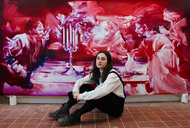Artist Lily Macrae on her journey as an artist and what inspires her practice
Posted by Cass Art on 16th Apr 2021
Lily Macrae is a Glasgow based contemporary artist who also is one of our staff artists based in our Glasgow branch. Her work explores the compositional chaos and power struggles portrayed in the work of old masters such as Constable and Rubens. Here in her interest lies in their ability to deliver a timeless portrayal of humanity. We were delighted to speak to Lily about her journey as an artist, what inspires her incredible compositions and how she got on creatively in 2020. Enjoy!
Hi Lily, thanks so much for taking the time to speak to us. Firstly, could you tell us a bit about what inspired you to become an artist?
Hello!! Definitely, well it wasn’t really something I ever planned – but always what I enjoyed the most, so I suppose I just naturally fell into it. My family are all really creative in wildly different ways and there were a couple of exhibitions I saw when I was younger which convinced me that pursuing it was the right choice. I saw a solo of Robert Rauschenberg’s work in Inverleith house in Edinburgh in 2011 which I was completely in awe after, I’ve still got the catalogue on a shelf in the studio! When I saw that show I just decided if I didn’t study art now it would be hard to go back to it and I’m so glad I did.

I read you completed a residency in Toyko, Japan. What did this entail and how do you think this developed your artistic practice?
I did, I went out to Tokyo in 2019 and did a month-long residency with 3331 Arts Chiyoda which is an arts centre based in a former school in central Tokyo. It held events and workshops and actually houses some of the city's art galleries. I managed to secure a couple of grants and get some funding from The Hope Scott Trust and The Great Britain Sasakawa Foundation which meant that I could just go out and solely focus on my practice and painting which was incredible and I then had a couple of shows at the end. I spent the month making large-scale works influenced by the Japanese old masters and ukiyo-e woodblock printing. Tokyo is such a strangely isolated place, despite being one of the most populated cities in the world, which to be honest was perfect for me at the time. It just gave me the focus and distance to make new work and figure out the direction I wanted to head in.
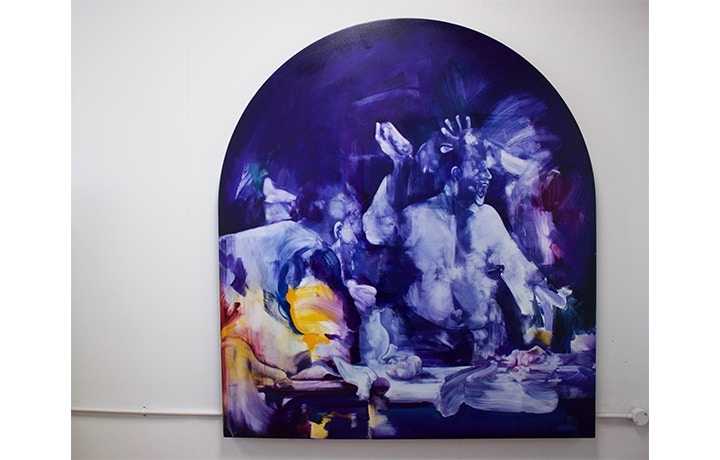
The Hypocrites,160 x 180 cm, oil on canvas, 2020
There is a glorious epic nature to your style of painting with the not only the composition but also the sense of motion you’re able to capture. How did you develop this unique style? Also, looking at your works artists like Caravaggio and Grammatica can spring to mind, are there any artistic movements or figures that have influenced you?
I think it has just developed naturally and still is changing with every work, when I started painting my works were nowhere near as obviously figurative as they are now. I go through sort of obsessions with different painters and with my recent work it has been rooted in this fascination with Caravaggio’s works – just the sheer power in them, the contrast and the way he used light is something I’d like to achieve within my own pieces. I could list influences all day: Francis Bacon, Peter Paul Rubens and contemporary painters Flora Yukhnovich and Yukimasa IDA – check them out their works are so wildly different but so strong.
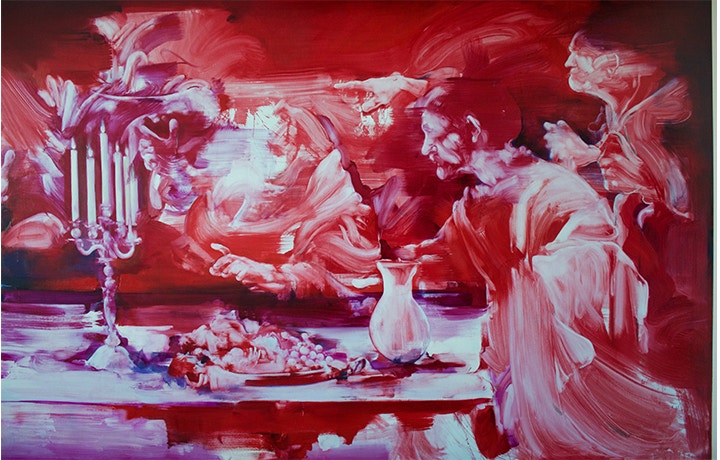
Rule of Six (detail) 300 x 150 cm, oil on canvas, 2020
In your work there are moments of abstraction and figuration. Classical composition but presented in a contemporary manner. Can you talk to us about how you’re able to strike such a perfect balance of both?
Thank so much, I want to try to capture that spontaneity of movement and motion you get at the very start of a painting, for each work to hint to the actual process of painting first and foremost before figuration even enters into it. There is always this push and pull of figuration and not wanting the outcome to be too obvious. I’m more concerned with keeping that initial burst of energy within the finished work and the figures come in further into the process. When I start a painting, I will usually have some sort of composition in mind – figures drawn from both historical paintings and sources but also more recently during lockdown I have been combining these with film stills and more contemporary imagery. I’m not concerned with anything being realistic, quite the opposite actually I want there to be the element of storytelling which for me is innate in figuration but alongside the excitement of abstraction and that space in between which allows the viewer to attach their own meaning.
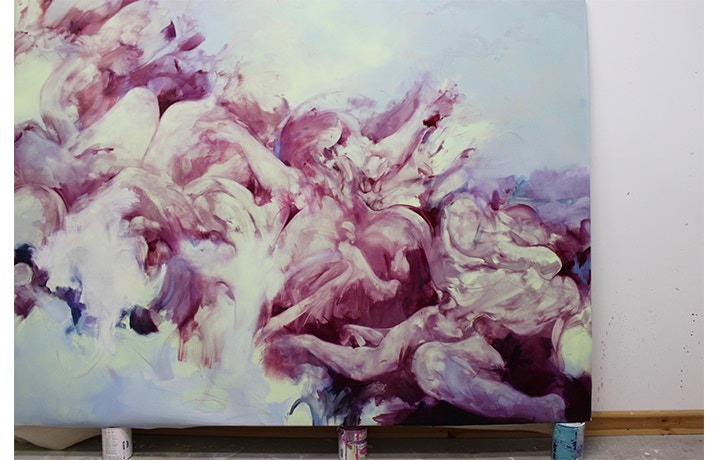
Decadence and Debauchery, 200 x 150cm, oil on canvas
If we were to wander into your studio what materials would we find and why are these integral to your practice?
If you were to wander in it would definitely be to a mess! There is constantly stuff all over the floor and walls. Materials wise I never stray too far from oil painting, I’m a huge fan of Michael Harding oils - the pigments in them are incredible and quite often use Winsor and Newton oils too. Winsor and Newton liquin is my absolute saviour as well I use a LOT of it, and any kind of medium like the Zest it painting medium. I usually apply the paint and then remove it with brushes and fabric - almost like a negative way of applying the paint. It means I can move the paint around freely and create different tones and effects with it, so use loads of different types of mediums. I build and stretch my canvases so there are a lot of stretcher bars and rolls of canvas lying around too!
Looking at your Instagram feed (Which is a feast for the eyes I must say!) what strikes firstly is that you’re a prolific painter but also the incredible array of colour on display. How do you approach a blank canvas and a choose a colour palette?
Before starting the bigger pieces, I generally do some compositional drawings and then will map out the main shapes on the canvas just with a line drawing. Then I’ll do a series of really small abstract colour studies on paper which are how I plan my colour choices. I usually limit myself to 2 or 3 main colours to start off with or I get a bit carried away and use them all! I feel like colour choices just sort of fall into place naturally, I try not to plan it too much. I’ve always found that I can get the depth I want to achieve with just a few colours.
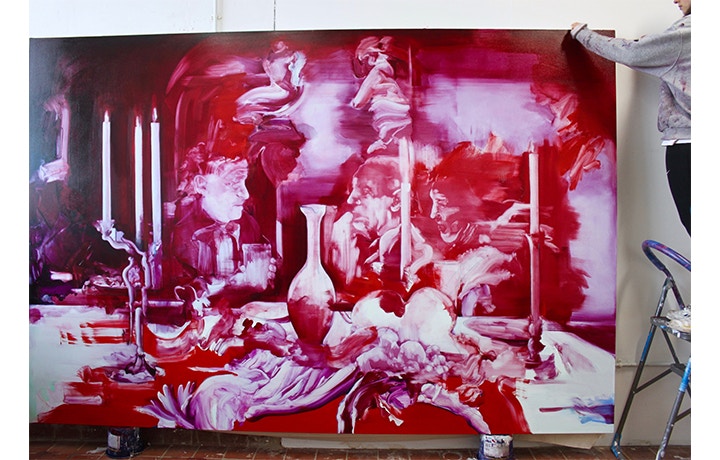
Working on Night Watchers 300 x 200 cm, oil on canvas
We’ve been speaking to quite a few artists over the last 12 months about how lockdown has affected their creative production. Some found it quite productive, some found it a great time to reflect over their entire practice and others said their creativity was diminished by it. How have you found the last few months from a creative perspective?
It has been a really weird year and I feel guilty for saying it but really good in some ways to have so much uninterrupted time to paint. At the start of lock down I got one of The Royal Scottish Academy’s Pandemic award grants which was this really generous funding to make a body of work as a personal response to covid-19. That culminated in a group show which was in January. It enabled me to make quite ambitious work and also gave me the drive to keep going, without the deadline I’m not sure I would’ve been so productive so I’m so grateful!

studio shot making new circular tondos
Finally, what can we look out for in 2021 from you Lily?
Loads of exciting things lined up actually, I’ve been doing a bit of work with the curator at Paul Smith’s Albemarle Mayfair Gallery and have made a series of smaller circular tondo pieces which are going into a group show with the furniture designer Tom Faulkner in his showroom in Chelsea. I think as part of London Design week but this is all of course covid dependent. I’ve also got a London solo in the planning stages which will hopefully take place in summer/autumn 2021 which will be a great way to show some of the work I’ve made over the past year plus the new paintings I’m starting at the moment. 2022 is pretty much booked up too! I’ve been working with a few International collectors and hoping to have an International exhibition by the end of the year or into the start of next year as well as some interesting collaborations hopefully. I quite like having lots of paintings on the go so that I can let each one dry or have a break from looking at them and go back with a fresh perspective so it's great to have so much going on!
Amazing! Thanks so much for taking the time to speak to us and the very best of luck with all your amazing projects coming up.
You can check out Lily's work on her website and do follow her on her Instagram also.
FEELING INSPIRED?
Don't forget to hashtag #cassart on social media to show us your creations.

